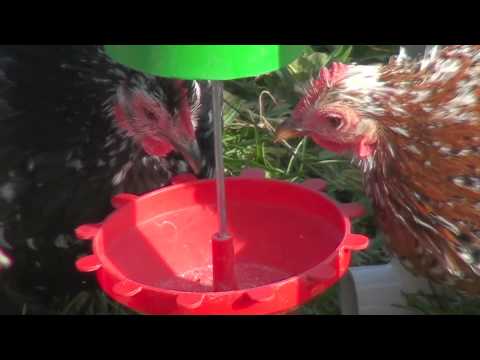Guess what happened! When I sat down in the chicken yard, yesterday (after a few days of not visiting them because I wasn't feeling well), I noticed that 4 of our 8 girls (probably the ones that have started laying) had gained weight and were pecking on the other 4. They had never done this before. I also noticed that the other 4 had not gained any weight. (This must have happened within a week or so.)
There never seemed to be a hierarchy before, and they had all eaten corncobs peacefully from my hand. Now only the fatter and stronger ones ate from my hand. The others didn't dare to come.
I told my husband that he needed to install a second feeder asap. For now we have only one feeder (made out of a plumbing pipe, as seen here on BYC). I am afraid the, meanwhile, bigger and fatter 4 girls don't allow the others to eat from the feeder. Buggers!
We also feed "Weichfutter" (German for "soft food", that is kitchen scraps, cooked potato peels and potato leftovers, etc.), and the recently finished summer enclosure, to which our chickens have finally moved, is about 1,200 sqft large. So the deprived chickens would not have starved, but we definitely have to make sure that the 4 bossy ones can't keep the others away from the main food source.
Has anyone else had this problem?
There never seemed to be a hierarchy before, and they had all eaten corncobs peacefully from my hand. Now only the fatter and stronger ones ate from my hand. The others didn't dare to come.
I told my husband that he needed to install a second feeder asap. For now we have only one feeder (made out of a plumbing pipe, as seen here on BYC). I am afraid the, meanwhile, bigger and fatter 4 girls don't allow the others to eat from the feeder. Buggers!
We also feed "Weichfutter" (German for "soft food", that is kitchen scraps, cooked potato peels and potato leftovers, etc.), and the recently finished summer enclosure, to which our chickens have finally moved, is about 1,200 sqft large. So the deprived chickens would not have starved, but we definitely have to make sure that the 4 bossy ones can't keep the others away from the main food source.
Has anyone else had this problem?

 but I have to say that now I want some German potato salad!! My (very german) grandma always made the best! My mom is trying to teach me, but I've yet to get it just right
but I have to say that now I want some German potato salad!! My (very german) grandma always made the best! My mom is trying to teach me, but I've yet to get it just right


